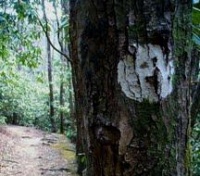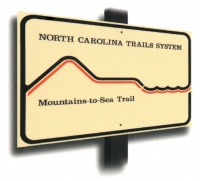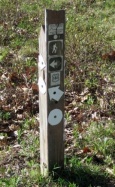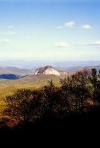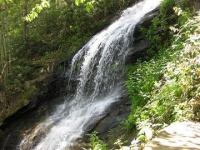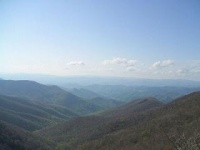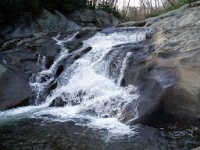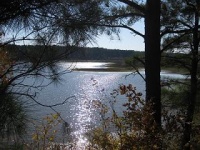The Mountains-to-Sea Trail (MST) is one of the newest and most scenic long-distance trails in the region.
Maintained by the Friends of the Mountains-to-Sea Trail and its affiliated groups & agencies, it travels from
the 6,643 foot peak of Clingman's Dome to the sand dunes of Jockey's Ridge State Park, NC. Even though it
is still being constructed, it is nearly a 1,000-mile journey that is routed through the state of North Carolina
on new and existing trails, country roads, through state parks, and along the coastal beaches.
The Mountains-to-Sea Trail is uniquely blazed by white dots. The trail is also marked by carsonites, posts, and signs with the Mountains-to-Sea Trail logo.
The MST's mountain section (Clingman's Dome to Stone Mountain State Park, NC) has numerous trailheads that are within an hour or two drive of the Tri-Cities. The trail starts in the Great Smoky Mountains Naitonal Park, and passes through the Nantalhala/Pisgah National Forests, the cities of Asheville & Blowing Rock, climbs to the top of Mount Mitchell, and travels alongside the Blue Ridge Parkway. A number of its sections offer from easy access along the Parkway to the most remote & mountainous backcountry and wilderness areas. Difficulty of the trail can range from easy to difficult; level hillside to steep and rocky grades.
After Stone Mountain State Park, the MST travels through the backroads and state parks of the North Carolina Piedmont to the Outer Banks.
The MST has recently undergone significant re-routing when leaving the Great Smoky Mountains National Park and on the North Carolina Piedmont and Coastal Plain sections.
Loading map...
{"type":"TERRAIN","minzoom":false,"maxzoom":false,"types":["ROADMAP","SATELLITE","HYBRID","TERRAIN"],"mappingservice":"googlemaps3","width":"auto","height":"400px","centre":false,"title":"","label":"","icon":"","lines":[],"polygons":[],"circles":[],"rectangles":[],"copycoords":false,"static":false,"visitedicon":"","wmsoverlay":false,"zoom":false,"layers":[],"controls":["pan","zoom","type","scale","streetview","rotate"],"zoomstyle":"DEFAULT","typestyle":"DEFAULT","autoinfowindows":false,"resizable":false,"kmlrezoom":false,"poi":true,"cluster":false,"clustergridsize":60,"clustermaxzoom":20,"clusterzoomonclick":true,"clusteraveragecenter":true,"clusterminsize":2,"imageoverlays":[],"kml":[],"gkml":[],"searchmarkers":"","fullscreen":false,"scrollwheelzoom":false,"locations":[{"text":"\u003Cb\u003E\u003Cdiv class=\"mw-parser-output\"\u003E\u003Cp\u003EClingman's Dome\n\u003C/p\u003E\u003C/div\u003E\u003C/b\u003E\u003Cdiv class=\"mw-parser-output\"\u003E\u003Cp\u003EWestern Terminus\u003Cbr /\u003ESection 1 trailhead\n\u003C/p\u003E\u003C/div\u003E","title":"Clingman's Dome\n","link":"","lat":35.5629404000000022278982214629650115966796875,"lon":-83.49844899999999370265868492424488067626953125,"icon":""},{"text":"\u003Cb\u003E\u003Cdiv class=\"mw-parser-output\"\u003E\u003Cp\u003ESection 1 Route Split @ Campsite 57 - Deep Creek Trail\n\u003C/p\u003E\u003C/div\u003E\u003C/b\u003E\u003Cdiv class=\"mw-parser-output\"\u003E\u003Cp\u003E(1A - Great Smoky Mountains Route / 1B - Tuckaseegee River Valley Route)\n\u003C/p\u003E\u003C/div\u003E","title":"Section 1 Route Split @ Campsite 57 - Deep Creek Trail\n","link":"","lat":35.520544999999998481143848039209842681884765625,"lon":-83.4188170000000042136889533139765262603759765625,"icon":""},{"text":"\u003Cdiv class=\"mw-parser-output\"\u003E\u003Cp\u003EBryson City, NC (1B)\n\u003C/p\u003E\u003C/div\u003E","title":"Bryson City, NC (1B)\n","link":"","lat":35.43204200000000270165401161648333072662353515625,"lon":-83.421548999999998841303749941289424896240234375,"icon":""},{"text":"\u003Cdiv class=\"mw-parser-output\"\u003E\u003Cp\u003EOcanaluftee Visitor's Center\n\u003C/p\u003E\u003C/div\u003E","title":"Ocanaluftee Visitor's Center\n","link":"","lat":35.50585430000000286554495687596499919891357421875,"lon":-83.3014299999999963119989843107759952545166015625,"icon":""},{"text":"\u003Cdiv class=\"mw-parser-output\"\u003E\u003Cp\u003ESoco Gap\n\u003C/p\u003E\u003C/div\u003E","title":"Soco Gap\n","link":"","lat":35.49673560000000094305505626834928989410400390625,"lon":-83.1555599999999941474015940912067890167236328125,"icon":""},{"text":"\u003Cb\u003E\u003Cdiv class=\"mw-parser-output\"\u003E\u003Cp\u003EWaterrock Knob and the Plott Balsams\n\u003C/p\u003E\u003C/div\u003E\u003C/b\u003E\u003Cdiv class=\"mw-parser-output\"\u003E\u003Cp\u003EPoint of Interest\n\u003C/p\u003E\u003C/div\u003E","title":"Waterrock Knob and the Plott Balsams\n","link":"","lat":35.464268099999998185012373141944408416748046875,"lon":-83.1376431000000053472831496037542819976806640625,"icon":"/clubwiki/images/MarkerG.png"},{"text":"\u003Cdiv class=\"mw-parser-output\"\u003E\u003Cp\u003EBalsam Gap\n\u003C/p\u003E\u003C/div\u003E","title":"Balsam Gap\n","link":"","lat":35.43409969999999731271600467152893543243408203125,"lon":-83.07432199999999511419446207582950592041015625,"icon":""},{"text":"\u003Cdiv class=\"mw-parser-output\"\u003E\u003Cp\u003EBear Pen Gap\n\u003C/p\u003E\u003C/div\u003E","title":"Bear Pen Gap\n","link":"","lat":35.32174340000000256623025052249431610107421875,"lon":-82.964888000000001966327545233070850372314453125,"icon":""},{"text":"\u003Cdiv class=\"mw-parser-output\"\u003E\u003Cp\u003ENC-215\n\u003C/p\u003E\u003C/div\u003E","title":"NC-215\n","link":"","lat":35.3039447999999964622475090436637401580810546875,"lon":-82.90906499999999823558027856051921844482421875,"icon":""},{"text":"\u003Cdiv class=\"mw-parser-output\"\u003E\u003Cp\u003EGraveyard Fields/Ridge and Black Balsams\n\u003C/p\u003E\u003C/div\u003E","title":"Graveyard Fields/Ridge and Black Balsams\n","link":"","lat":35.3204477999999966186805977486073970794677734375,"lon":-82.8618909999999999627107172273099422454833984375,"icon":""},{"text":"\u003Cdiv class=\"mw-parser-output\"\u003E\u003Cp\u003EPisgah Inn\n\u003C/p\u003E\u003C/div\u003E","title":"Pisgah Inn\n","link":"","lat":35.4026099000000016303602023981511592864990234375,"lon":-82.757072899999997162012732587754726409912109375,"icon":""},{"text":"\u003Cdiv class=\"mw-parser-output\"\u003E\u003Cp\u003EFolk Art Center\n\u003C/p\u003E\u003C/div\u003E","title":"Folk Art Center\n","link":"","lat":35.59235199999999821329765836708247661590576171875,"lon":-82.482066000000003214154276065528392791748046875,"icon":""},{"text":"\u003Cb\u003E\u003Cdiv class=\"mw-parser-output\"\u003E\u003Cp\u003ECraggy Gardens and Mountains\n\u003C/p\u003E\u003C/div\u003E\u003C/b\u003E\u003Cdiv class=\"mw-parser-output\"\u003E\u003Cp\u003EPoint of Interest\n\u003C/p\u003E\u003C/div\u003E","title":"Craggy Gardens and Mountains\n","link":"","lat":35.7058329999999983783709467388689517974853515625,"lon":-82.366667000000006737536750733852386474609375,"icon":"/clubwiki/images/MarkerG.png"},{"text":"\u003Cb\u003E\u003Cdiv class=\"mw-parser-output\"\u003E\u003Cp\u003EMt. Mitchell State Park and the Black Mountains\n\u003C/p\u003E\u003C/div\u003E\u003C/b\u003E\u003Cdiv class=\"mw-parser-output\"\u003E\u003Cp\u003EPoint of Interest\n\u003C/p\u003E\u003C/div\u003E","title":"Mt. Mitchell State Park and the Black Mountains\n","link":"","lat":35.76480000000000103455022326670587062835693359375,"lon":-82.2651000000000038880898500792682170867919921875,"icon":"/clubwiki/images/MarkerG.png"},{"text":"\u003Cdiv class=\"mw-parser-output\"\u003E\u003Cp\u003EBalsam Gap\n\u003C/p\u003E\u003C/div\u003E","title":"Balsam Gap\n","link":"","lat":35.7489503999999982397639541886746883392333984375,"lon":-82.3340749999999985675458447076380252838134765625,"icon":""},{"text":"\u003Cdiv class=\"mw-parser-output\"\u003E\u003Cp\u003EBuck Creek Gap\n\u003C/p\u003E\u003C/div\u003E","title":"Buck Creek Gap\n","link":"","lat":35.77092470000000190566424862481653690338134765625,"lon":-82.1649460000000004811226972378790378570556640625,"icon":""},{"text":"\u003Cdiv class=\"mw-parser-output\"\u003E\u003Cp\u003EUS-221 @ Woodlawn\n\u003C/p\u003E\u003C/div\u003E","title":"US-221 @ Woodlawn\n","link":"","lat":35.76698999999999983856469043530523777008056640625,"lon":-82.04117800000000215732143260538578033447265625,"icon":""},{"text":"\u003Cb\u003E\u003Cdiv class=\"mw-parser-output\"\u003E\u003Cp\u003ETable Rock Rec. Area\n\u003C/p\u003E\u003C/div\u003E\u003C/b\u003E\u003Cdiv class=\"mw-parser-output\"\u003E\u003Cp\u003EPoint of Interest\n\u003C/p\u003E\u003C/div\u003E","title":"Table Rock Rec. Area\n","link":"","lat":35.88696399999999897545421845279633998870849609375,"lon":-81.8844509999999985438989824615418910980224609375,"icon":"/clubwiki/images/MarkerG.png"},{"text":"\u003Cdiv class=\"mw-parser-output\"\u003E\u003Cp\u003ERipshin Ridge\n\u003C/p\u003E\u003C/div\u003E","title":"Ripshin Ridge\n","link":"","lat":35.95216359999999866658981773070991039276123046875,"lon":-81.846599999999995134203345514833927154541015625,"icon":""},{"text":"\u003Cb\u003E\u003Cdiv class=\"mw-parser-output\"\u003E\u003Cp\u003EGragg Prong bridge\n\u003C/p\u003E\u003C/div\u003E\u003C/b\u003E\u003Cdiv class=\"mw-parser-output\"\u003E\u003Cp\u003E@ Roseborough Road/USFS 981\u003Cbr /\u003EPoint of Interest and Parking\n\u003C/p\u003E\u003C/div\u003E","title":"Gragg Prong bridge\n","link":"","lat":36.03167880000000167228790814988315105438232421875,"lon":-81.8029120000000062873368733562529087066650390625,"icon":"/clubwiki/images/MarkerG.png"},{"text":"\u003Cdiv class=\"mw-parser-output\"\u003E\u003Cp\u003EBeacon Heights\n\u003C/p\u003E\u003C/div\u003E","title":"Beacon Heights\n","link":"","lat":36.03167880000000167228790814988315105438232421875,"lon":-81.8029120000000062873368733562529087066650390625,"icon":""},{"text":"\u003Cdiv class=\"mw-parser-output\"\u003E\u003Cp\u003EUS-321/221 @ Blowing Rock\n\u003C/p\u003E\u003C/div\u003E","title":"US-321/221 @ Blowing Rock\n","link":"","lat":36.14847950000000054160409490577876567840576171875,"lon":-81.66309400000000096042640507221221923828125,"icon":""},{"text":"\u003Cdiv class=\"mw-parser-output\"\u003E\u003Cp\u003EDeep Gap\n\u003C/p\u003E\u003C/div\u003E","title":"Deep Gap\n","link":"","lat":36.229631200000000035288394428789615631103515625,"lon":-81.499539999999996098267729394137859344482421875,"icon":""},{"text":"\u003Cb\u003E\u003Cdiv class=\"mw-parser-output\"\u003E\u003Cp\u003EE.B. Jeffress Park and Cascade Falls\n\u003C/p\u003E\u003C/div\u003E\u003C/b\u003E\u003Cdiv class=\"mw-parser-output\"\u003E\u003Cp\u003EPoint of Interest\n\u003C/p\u003E\u003C/div\u003E","title":"E.B. Jeffress Park and Cascade Falls\n","link":"","lat":36.24690360000000310947143589146435260772705078125,"lon":-81.4578719999999947276592138223350048065185546875,"icon":"/clubwiki/images/MarkerG.png"},{"text":"\u003Cb\u003E\u003Cdiv class=\"mw-parser-output\"\u003E\u003Cp\u003EThe Lump\n\u003C/p\u003E\u003C/div\u003E\u003C/b\u003E\u003Cdiv class=\"mw-parser-output\"\u003E\u003Cp\u003EPoint of Interest\n\u003C/p\u003E\u003C/div\u003E","title":"The Lump\n","link":"","lat":36.27424090000000234113031183369457721710205078125,"lon":-81.3795089999999987639967002905905246734619140625,"icon":"/clubwiki/images/MarkerG.png"},{"text":"\u003Cdiv class=\"mw-parser-output\"\u003E\u003Cp\u003EHorse Gap @ NC-16\n\u003C/p\u003E\u003C/div\u003E","title":"Horse Gap @ NC-16\n","link":"","lat":36.312842799999998533166944980621337890625,"lon":-81.362943999999998823113855905830860137939453125,"icon":""},{"text":"\u003Cdiv class=\"mw-parser-output\"\u003E\u003Cp\u003EBRP and NC-18\n\u003C/p\u003E\u003C/div\u003E","title":"BRP and NC-18\n","link":"","lat":36.39102580000000131121851154603064060211181640625,"lon":-81.2455700000000007321432349272072315216064453125,"icon":""},{"text":"\u003Cdiv class=\"mw-parser-output\"\u003E\u003Cp\u003EDevil's Garden Overlook\n\u003C/p\u003E\u003C/div\u003E","title":"Devil's Garden Overlook\n","link":"","lat":36.434265699999997423219610936939716339111328125,"lon":-81.1043789999999944484443403780460357666015625,"icon":""},{"text":"\u003Cdiv class=\"mw-parser-output\"\u003E\u003Cp\u003EStone Mountain State Park\n\u003C/p\u003E\u003C/div\u003E","title":"Stone Mountain State Park\n","link":"","lat":36.39372039999999941528585623018443584442138671875,"lon":-81.0419370000000043319232645444571971893310546875,"icon":""},{"text":"\u003Cb\u003E\u003Cdiv class=\"mw-parser-output\"\u003E\u003Cp\u003EPilot Mountain State Park\n\u003C/p\u003E\u003C/div\u003E\u003C/b\u003E\u003Cdiv class=\"mw-parser-output\"\u003E\u003Cp\u003EPoint of Interest\n\u003C/p\u003E\u003C/div\u003E","title":"Pilot Mountain State Park\n","link":"","lat":36.34338919999999717447281000204384326934814453125,"lon":-80.465948999999994839527062140405178070068359375,"icon":"/clubwiki/images/MarkerG.png"},{"text":"\u003Cb\u003E\u003Cdiv class=\"mw-parser-output\"\u003E\u003Cp\u003EHanging Rock State Park\n\u003C/p\u003E\u003C/div\u003E\u003C/b\u003E\u003Cdiv class=\"mw-parser-output\"\u003E\u003Cp\u003EPoint of Interest\n\u003C/p\u003E\u003C/div\u003E","title":"Hanging Rock State Park\n","link":"","lat":36.403392400000001316584530286490917205810546875,"lon":-80.260277000000002090018824674189090728759765625,"icon":"/clubwiki/images/MarkerG.png"},{"text":"\u003Cb\u003E\u003Cdiv class=\"mw-parser-output\"\u003E\u003Cp\u003EGreensboro Watershed\n\u003C/p\u003E\u003C/div\u003E\u003C/b\u003E\u003Cdiv class=\"mw-parser-output\"\u003E\u003Cp\u003EPoint of Interest\n\u003C/p\u003E\u003C/div\u003E","title":"Greensboro Watershed\n","link":"","lat":36.1755739999999974543243297375738620758056640625,"lon":-79.852408999999994421159499324858188629150390625,"icon":"/clubwiki/images/MarkerG.png"},{"text":"\u003Cb\u003E\u003Cdiv class=\"mw-parser-output\"\u003E\u003Cp\u003EEno River State Park\n\u003C/p\u003E\u003C/div\u003E\u003C/b\u003E\u003Cdiv class=\"mw-parser-output\"\u003E\u003Cp\u003EPoint of Interest\n\u003C/p\u003E\u003C/div\u003E","title":"Eno River State Park\n","link":"","lat":36.042783700000001090302248485386371612548828125,"lon":-79.000281999999998561179381795227527618408203125,"icon":"/clubwiki/images/MarkerG.png"},{"text":"\u003Cb\u003E\u003Cdiv class=\"mw-parser-output\"\u003E\u003Cp\u003EFalls Lake\n\u003C/p\u003E\u003C/div\u003E\u003C/b\u003E\u003Cdiv class=\"mw-parser-output\"\u003E\u003Cp\u003EPoint of Interest\n\u003C/p\u003E\u003C/div\u003E","title":"Falls Lake\n","link":"","lat":36.01390769999999719175320933572947978973388671875,"lon":-78.689875999999998157363734208047389984130859375,"icon":"/clubwiki/images/MarkerG.png"},{"text":"\u003Cb\u003E\u003Cdiv class=\"mw-parser-output\"\u003E\u003Cp\u003ECroatan National Forest\n\u003C/p\u003E\u003C/div\u003E\u003C/b\u003E\u003Cdiv class=\"mw-parser-output\"\u003E\u003Cp\u003ENeusiok Trail\u003Cbr /\u003EPoint of Interest\n\u003C/p\u003E\u003C/div\u003E","title":"Croatan National Forest\n","link":"","lat":34.8349410000000005993570084683597087860107421875,"lon":-76.80747999999999819920049048960208892822265625,"icon":"/clubwiki/images/MarkerG.png"},{"text":"\u003Cb\u003E\u003Cdiv class=\"mw-parser-output\"\u003E\u003Cp\u003EJockey's Ridge State Park\n\u003C/p\u003E\u003C/div\u003E\u003C/b\u003E\u003Cdiv class=\"mw-parser-output\"\u003E\u003Cp\u003EEastern Terminus\n\u003C/p\u003E\u003C/div\u003E","title":"Jockey's Ridge State Park\n","link":"","lat":35.9614040000000017016645870171487331390380859375,"lon":-75.6347750000000047521098167635500431060791015625,"icon":""}]}
Currently there are 2 trails covering 17.1 miles of this trail system documented on this wiki.
Before venturing out over-night on the Mountains-to-Sea Trail, hikers must be aware that camping permissions along the Mountain-to-Sea Trail varies greatly. So proper planning and researching needs to be conducted. Though camping is permitted in most of the backcountry areas in the Nantalhala and Pisgah National Forests, there are camping restrictions on other parts of the trail. The trail section inside the Smokies (GSMNP) requires a backcountry permit and campsite reservations. Along the Blue Ridge Parkway, camping is prohibited except at Parkway campgrounds (proper registration required). Camping is permitted inside Mount Mitchell and Stone Mountain State Parks at only approved sites (proper registration required). Open fire regulations also need to be followed for each site depending on agency regulations.
The National Park Service is advising MST hikers to NOT hike the original route along the Parkway between the Oconaluftee River To Balsam Gap due to possible dangers of walking through the Parkway tunnels.
Two new routes have been created to bypass the tunnels. Route A takes a longer backcountry route through the Smokies to exit near Cataloochee Ranch and onward to Soco Gap then Waterrock Knob. Route B exits the park at Deep Creek near Bryson City and continues on roads toward Pinnacle Park & Waterrock Knob near Sylva/Waynesville. From Waterrock Knob, the MST is on established trail with short crossings of the parkway and forest roads.
